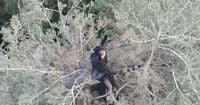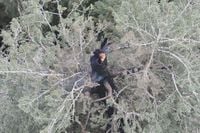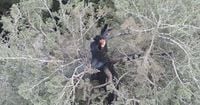In the misty forests of Oregon’s southern coast, a living giant is fighting for survival. The Doerner Fir, a coastal Douglas fir that soars over 325 feet into the sky and is believed to be more than 450 years old, has become the unlikely center of an intense firefighting effort after flames were spotted licking its upper reaches on Saturday, August 16, 2025. The tree, revered by locals and scientists alike, now stands at the heart of a battle between nature’s resilience and the unpredictable threat of wildfire.
The first alarm was raised at 2:30 p.m. that Saturday, when the Coos Forest Protective Association received a call about a fire on U.S. Bureau of Land Management land east of Coquille, Oregon, according to Oregon Public Broadcasting (OPB). What firefighters found was both awe-inspiring and alarming: the Doerner Fir, one of the world’s tallest known trees, was burning from within. Helicopter teams quickly doused flames engulfing the canopy, but the real challenge lay hidden deep inside the trunk, some 250 to 280 feet above the ground.
By Tuesday, August 19, 2025, the situation had evolved. An infrared drone flight revealed no active flames or smoke at the top, but it did detect persistent heat within a cavity about 280 feet high, as reported by the Associated Press and confirmed by federal Bureau of Land Management (BLM) spokesperson Megan Harper. That hidden heat source has proven tricky to reach, and firefighters have been forced to get creative. Options considered included building scaffolding, climbing adjacent trees, or even simply letting the fire smolder while monitoring for reignition.
But not all strategies are feasible. Fallout from the treetop made it too risky for climbing crews to reach the stubborn fire inside the trunk, prompting teams to search for other solutions, according to a BLM press release. In the meantime, crews set up containment lines and placed sprinklers at the base of the tree, determined to keep the fire from spreading along the forest floor. A helicopter remained on standby for further water drops, and the Doerner Fir Recreation Area was closed to the public until further notice.
The firefighting effort is as much about preservation as it is about containment. The Doerner Fir is not just any tree—it’s a living relic, a witness to centuries of history and a symbol of Oregon’s wild legacy. “I think people really love it,” Harper told the Associated Press. “There’s a lot of history there, and so we don’t want to lose it.” The tree’s age and stature have made it a magnet for scientists, nature lovers, and even thrill-seeking tree climbers. OPB’s Oregon Field Guide once met climbers who marveled at the Doerner Fir (previously known as the Brummit Fir), describing it as a rare survivor among giants that once dominated the landscape before intensive logging reduced their numbers.
Despite the dramatic images of smoke curling from its crown, officials remain cautiously optimistic about the tree’s fate. “Right now, that is not a danger,” Harper said when asked if the Doerner Fir might burn all the way down. “The tree is so big, it’s got so much mass that it would take a while for it to burn all the way through the tree.” She added, “Being a whole tree, the chances that the whole tree is going to burn is pretty small. I think that there will definitely be the Doerner Fir still there.”
Still, the fire has left its mark. About 50 feet—nearly 15 meters—of the tree’s top have been lost, either consumed by flames or broken off by falling debris. This significant reduction in height could affect the Doerner Fir’s standing in global rankings of the tallest trees, but Harper was quick to point out, “I don’t know where it’ll stand after this, but it’s still a magnificent tree.”
Throughout the ordeal, firefighting crews have remained on-site, adjusting tactics as the situation evolves. Helicopter bucket drops on Monday, August 18, managed to reduce fire activity near the top, and the sprinklers and containment lines at the base help ensure the fire doesn’t spread to the surrounding forest. The dedication of these teams is clear: they’re committed to doing everything possible to save the historic tree, a sentiment echoed by Harper, who noted both the scientific and emotional significance of the Doerner Fir to Oregonians and beyond.
As for the cause of the fire, it remains a mystery. Investigators with the Bureau of Land Management have ruled out lightning as a culprit based on weather data, though the tree’s height typically makes it more vulnerable to strikes. “It’s actually pretty rare to have one of these big old trees catch fire like this,” Harper admitted to OPB, underlining the unusual nature of the incident. The fact that the Doerner Fir is the only tree burning in the immediate area has only deepened the puzzle. For now, the investigation continues, with officials combing through data and environmental clues in hopes of pinpointing what sparked the blaze.
The fire has also brought renewed attention to the broader context of Oregon’s forests. The Doerner Fir is a rare survivor from an era when the region was home to many such giants. Years of logging and environmental change have left few trees of its stature, making its preservation all the more urgent. The incident has sparked conversations about forest management, fire prevention, and the delicate balance between human activity and the natural world—a balance that, in this case, hangs on the fate of a single, ancient tree.
For now, the Doerner Fir stands battered but unbowed, its fate uncertain but far from sealed. As firefighting crews continue their efforts, the world watches, hoping that one of nature’s titans will weather yet another storm. The story of the Doerner Fir is a reminder of both the vulnerability and resilience of the natural world—and the lengths to which people will go to protect the living monuments that connect us to our past.






